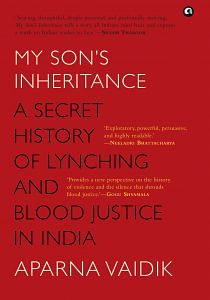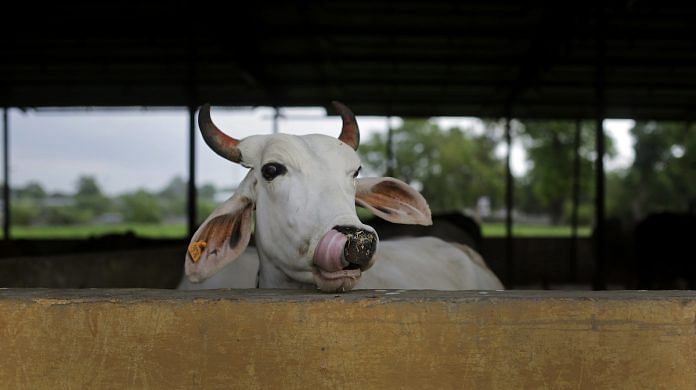The cow protection movement also inventively used the thriving visual and print culture of books, journals, magazines, pamphlets, handbills, posters, cartoons, chapbooks, and newspapers for publicizing its cause. By the second half of the nineteenth century, printing had grown into a big industry with a network of ancillary industries involved in manufacturing printing machines, paper, and dyes that were used for printing; and once printed, for distribution and circulation of the material in different forms. The low-cost mass printing of images (paintings, photographs, drawings, cartoons, and religious art) gave further impetus to the vigorous print culture. The Naval Kishore Press at Lucknow, Sri Venkateshwar Press, and the Raja Ravi Varma Press in Bombay were some of the printing presses at the forefront of the print revolution. Print created a new public culture of debate, dialogue, and controversies akin to social media today. Different communities were printing and disseminating their religious texts, opinions of their leaders, and propaganda materials. There was equal room for divergent opinions and ideas contesting each other to circulate.
The generations from the late nineteenth century onwards grew up immersed in this print culture, encountering it at news stands, railway bookstalls, road intersections, outside schools, colleges, temples, and hospitals, at religious fairs and festivals; and as pocket-sized images that people could carry in their wallets or stick or hang on the walls of their homes or keep in the family altar. The printed material circulated rapidly because it was cheap and portable. Even poor people could afford calendars and cheap prints to decorate their homes. The use of everyday spoken languages also made the printed word accessible to a wide cross section of society. From the ones who could read to the ones who could not read—the latter could hear it being read aloud. Printing created new avenues of mass dissemination of information about everything under the sun. It also enabled mass education with the publication of school texts, children’s books and the growth of a new culture of school and public libraries. It allowed sections of the population such as children, women, the poor, and the lower castes to participate, engage, and have a voice in the public sphere as new forms of literature such as novels, autobiographies, journals, and magazines evolved. Access to reading and writing books changed social relations, engendered new ideological struggles, and transformed peoples’ consciousness. Hereon books became a testament to the power of the printed word, a form of encoding human thought that couldn’t easily be erased.
Under the influence of the Nagari Pracharini Sabha of Banaras (1893) and the Hindi Sahitya Sammelan of Allahabad (1910) that established an ancient ancestry for the Hindi language going back to Sanskrit, Hindi became the vehicle for spreading the message of gauraksha. Many tracts and magazines such as Gausewak, Gaudharma Prakash, Bharat Dimdima Natak, Gaumata ka Sandesh eulogizing the cow and the need for cow protection came into circulation. Alongside the image of the gaumata, the cow as the mother of all Hindus, was mass produced and consumed. In these images, the body of the cow was presented as a repository of all Hindu gods, eighty-four of them. Tucked away in the corner of these images (see image on p. 36) was the figure of a villainous butcher depicted as a wild boar (on top of the image is inscribed: kalyugi mansahari jeevon ko dekho, see the meat-eaters of kaliyug) who in order to satiate his lust for cow meat was poised to recklessly annihilate the sacred symbol of the Hindus. The dharmaraj, upholder of dharma, a Hindu man is shown begging the butcher for mercy saying ‘mat maro gaye sarv ka jeevan hai’, don’t kill the life-giving cow that serves all. The ‘all’ here refers to the national community sitting below the cow’s belly waiting to receive cow milk—the Hindus(three male figures—a reference to the dvija, the three twice-born castes of the Brahmana, Kshatriya, and Vaishya), and a single image of a Parsi, a Christian, and a Muslim man. This was the image of the Indian nation capacious enough to include Hindus, Muslims, Christians, and Parsis.
In other images the gaumata, the giver of milk that nourished the Hindu body was presented as a suffering mother who beseeched and invoked her Hindu son’s manliness and sense of pride to save her life and honour. Or a woman is shown waiting patiently with a bowl for cow’s milk while the calf suckled at her udders reminiscent of Dayanand’s injunction not to milk the cow until a few months after giving birth to a calf. Thus Hindu selfhood came to be intimately tied to the protection of the cow in relation to the rogue Muslim who insisted on eating beef and spoke Urdu (a language that was considered as the effeminate language of dancing girls and prostitutes). The relentless endurance of these images in the popular domain is attested by the fact that this image first appeared in Azamgarh district in 1894, then reappeared in the Hindi journal Madhuri in 1937, and then again in the 1960s as a calendar image, and thence made its way to family altars and knick-knacks like coin boxes in most homes in northern India, and can now be found easily on the internet.
Also read: Muslims In India have sought ban on cow slaughter for decades. But politics didn’t allow it
It seems that by the late nineteenth century, the Hindu Khatiks or butchers did not undertake even the tanning of cow or buffalo hide. Although one doesn’t know conclusively how far back in history the Hindu Khatik’s aversion to handling cows went (or whether it can be attributed to the influence of Vaishnavism or to the Arya Samaj publicists) it was quite likely that it was primarily the Kasais, Muslim butchers, who were handling cattle in northern India in this period. The spectre of the Muslim butcher, the Kasai, was thus born. It was an image of the rapacious Other who possessed the meanest traits that one wanted to distance oneself from.
 This excerpt from My Son’s Inheritance: A Secret History of Lynching and Blood Justice in India by Aparna Vaidik has been published with permission from Aleph Book Company.
This excerpt from My Son’s Inheritance: A Secret History of Lynching and Blood Justice in India by Aparna Vaidik has been published with permission from Aleph Book Company.







why write a fake book? even before the arrival of printing press, there were wars fought over Cow issue.